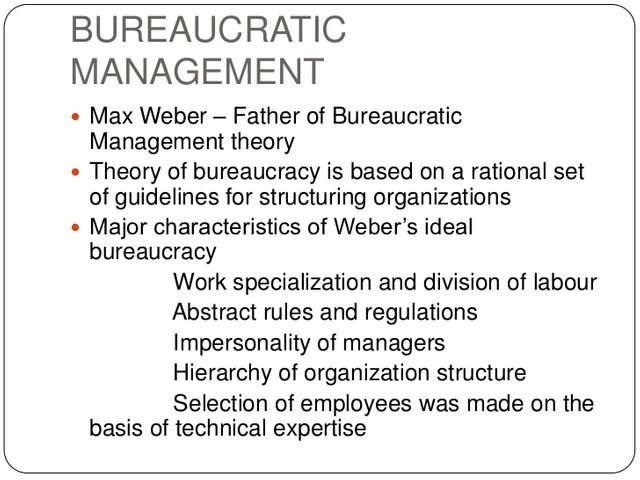Management theories - Most Popular Management Theories Decoded
CLASSICAL VIEW OF MANAGEMENT (SCIENTIFIC AND BUREAUCRATIC)
Classical Viewpoint is divided into three parts:
Scientific management
Bureaucratic management
Administrative management
1. Scientific Management:
Scientific management is defined as the use of the scientific method to define the “one best way” for a job to be done.
Frederick Winslow Taylor (1856-1915) (Father of Scientific Management)
He was the first nationally known management thinker. His “Taylorism” or “scientific management” was a major contribution to business operations as we know them today. The overview of his studies is given below:
a. Taylor developed scientific management to counter the problem of soldiering by workers— deliberately working below full capacity.
b. Taylor pioneered the time-and-motion study, where by a work task is broken down into its various motions, is improved by eliminating unnecessary motions, and then the motions timed to determine optimal daily production.
c. Through his four principles of scientific management, Taylor advocated scientific study of the task to find the best work method rather than relying on traditional methods handed down from one worker to another.
d. Taylor successfully implemented his theory at Bethlehem Steel in two famous studies involving shoveling and pig-iron handling. e Although real and imagined abuses or misuses of scientific management occurred (leading in one instance to a congressional investigation—and thereby adding to Taylor’s notoriety), Taylor’s strong support of science and his redefining the role of managers remains his primary contribution to management theory.
Taylor’s Four Principles of Scientific Management:
- Study each part of the task scientifically, and develop a best method to perform it.
- Carefully select workers and train them to perform a task using the scientifically developed method. 3. Cooperate fully with workers to ensure they use the proper method.
- Divide work and responsibility so management is responsible for planning work methods using scientific principles and workers are responsible for executing the work accordingly.
Frank and Lillian Gilbreth: They did studies aimed at eliminating unnecessary motions and way of reducing task fatigue.
a. They perfected the time-and-motion study techniques first introduced by Taylor.
b. Together they provided the first vocabulary for identifying hand, arm, and body motions used at work—which they called “Therbligs”.
c. Lillian’s doctoral dissertation was published as the book, The Psychology of Management, one of the first books published on the findings of psychology in the workplace.
d. Frank “proved” the value of motion studies in his own construction company whose productivity was nearly three times better than his competitors who used the older work methods.
How Do Today’s Managers Use Scientific Management? (Optional)
To understand why scientific management was viewed as such an important development, you need to look at the times in which Taylor, the Gilbreths, and other scientific management advocates lived.
- It was important because it could raise countries’ standards of living by making workers more productive and efficient.
- Also, it’s important to remember that many of the tools and techniques developed by the scientific management practitioners are still used in organizations today.
2. Bureaucratic Management:
GENERAL ADMINISTRATIVE THEORISTS
This group of writers focused on the entire organization. They’re important for developing more general theories of what managers do and what constitutes good management practice.
The two most prominent theorists behind the general administrative approach were Henri Fayol and Max Weber.
- Henri Fayol wrote during the same time period as Frederick Taylor. Fayol was the managing director of a large French coal-mining firm.
a. His attention was aimed at the activities of all managers.
b. He described the practice of management as distinct from other typical business functions. - Max Weber was a German sociologist who wrote in the early part of the 20th century.
a. He developed a theory of authority structures and described organizational activity based on authority relations.
b. He described the ideal form of organization—the bureaucracy, defined as a form of organization marked by division of labor, a clearly defined hierarchy, detailed rules and regulations, and impersonal relationships
Max Weber (1864-1920) a well-known German sociologist coined the term “bureaucracy” to apply to the ideal of large organizations operating on a rational basis. Weber’s original definition was much different than the definition of government red tape and bungling usually associated with the term “bureaucracy” today.
Characteristics of Weber’s Ideal Bureaucracy
The major characteristics of Weber’s ideal bureaucracy include:
a. Specialization of a labor
b. Formalization of rules and procedures
c. Impersonality in application of rules and sanctions
d. Formalization of lines of authority into a hierarchical structure
e. Formalization of the career advancement process to be based on merit
(Optional)
The timing of Weber’s contributions is a little confusing. Although he was a contemporary of Taylor and others described as “classical contributors,” Weber’s works weren’t translated into English until the 1940s. Weber’s bureaucratic characteristics are still evident in many of today’s large organizations—even in highly flexible organizations of talented professionals where some bureaucratic mechanisms are necessary to ensure that resources are used efficiently and effectively.
Contribution of the classical viewpoint:
Highlights the need for a scientific approach to management.
Points out that work methods often can be improved through study.
Identifies a number of important principles that are useful in running organization efficiently.
ADMINISTRATIVE VIEW OF MANAGEMENT
The Administrative Management It is a term used for those early-day contributors who developed and taught principles to be used by managers, both individually and collectively, to improve the performance of the overall functions of the organization.
Henri Fayol (1841-1925) a successful French industrialist, developed theories about management he thought could be taught to those individuals with administrative responsibilities.
Fayol gives us 14 principles of management which are still being used nowadays. These principles are given below:
Fayol’s 14 Principles of Management
Division of work.
Specialization increases output by making employees more efficient.
Authority.
Managers must be able to give order. Authority gives them this right. Along with authority, however, goes responsibility.
Discipline.
Employees must obey and respect the rules that govern the organization.
Unity of Command.
An employee should receive orders from one superior only.
Unity of direction.
The organization should have a single plan of action to guide managers and workers.
Subordination of individual interests to the general interest.
The interests of any one employee or group of employees should not take precedence over the interests of the organization as a whole.
Remuneration.
Workers must be paid a fair wage for their services.
Centralization.
This term refers to the degree to which subordinates are involved in decision making.
Scalar Chain.
The line term refers to the degree to which subordinates are involved in decision making.
Order.
People and materials should be in the right place at the right time.
Equity.
Managers should be kind and fair to their subordinates.
Stability of tenure of personnel
Management should provide orderly personnel planning and ensure that replacements are available to fill vacancies.
Initiative.
Employees who are allowed to originate and carry out plans will exert high levels of effort.
Esprit de corps: Promoting team spirit will build harmony and unity within the organization.
BEHAVIORAL THEORIES OF MANAGEMENT
Behavioral Viewpoint:
Organizational behavior (OB) research has contributed much of what we know about behavioral views of management, human resources management, motivation, leadership, trust, teamwork, and conflict management.
Four people stand out as early advocates of the OB approach. These include Robert Owen, Hugo Munsterberg, Mary Parker Follett, and Chester Barnard.
Hugo Munsterbeg (1863-1916) is considered to be the “father of industrial psychology” and is regarded by students of psychology as an important figure as Frederick Taylor is by students of management. Munsterberg attempted to develop practical applications of psychology. He argued that psychologists could help industry in three major areas:
a. Finding ways to identify individuals best suited to particular jobs.
b. Identifying the psychological conditions for optimum efficiency.
c. Finding ways to influence individual behavior to be congruent with management’s objectives
Mary Parker Follett (1868-1933) brought to management the perspectives of political science and social work. She identified:
a. The importance of the functioning of groups, not just individuals, in organization.
b. The principle of “power with” rather than “Power over” in management-employee relations.
c. Conflict resolution through integration, i.e., finding a solution to a conflict that would satisfy both parties.
d. The achievement of integrative unity, whereby the organization operates as a functional whole, with the various interrelated parts working together effectively to achieve organizational goals.
Hawthorne studies reflected the scientific management tradition of seeking greater efficiency by improving the tools and methods of work—in this case, lighting.
- In the first set of studies, no correlation was found between changes in lighting conditions and individual work performance. In fact, performance nearly always went up with any change— brighter or darker—in illumination.
- In the second set of studies, the concept of the Hawthorne effect emerged. The Hawthorne effect refers to the possibility that individuals singled out for a study may improve their performance simply because of the added attention they receive from the researchers, rather than because of any specific factors being tested in the study.
- The third set of studies centered on group production norms and individual motivation.
- Although simplistic and methodologically primitive, the Hawthorne studies established the impact that social aspects of the job (and the informal group) have on productivity.
Human Relations Movement: This movement was an attempt to equip managers with the social skills they need.
Abraham Maslow (1908-1970) developed a theory of motivation that was based on three assumptions about human nature.
a. Human beings have needs that are never completely satisfied.
b. Human behavior is aimed at satisfying the needs that are yet unsatisfied at a given point in time.
c. Needs fit into a somewhat predictable hierarchy ranging from basic, lower-level needs to higher-level needs:
- Physiological (lowest)
- Safety
- Belongingness or social
- Esteem
- Self-actualization (highest and NOT achieved by everyone)
Douglas McGregor (1906-1964) developed the Theory X and Theory Y dichotomy about the assumptions managers make about workers and how these assumptions affect behavior.
a. Theory X, managers tend to assume that workers are lazy, need to be coerced, have little ambition, and are focused on security needs. These managers then treat their subordinates as if these assumptions were true.
b. Theory Y managers tend to assume that workers do not inherently dislike work, are capable of self-control, have the capacity to be creative and innovative, and generally have higher-level needs that are often not met on the job. These managers then treat their subordinates as if these assumptions were true.
c. Workers, like all of us, tend to work up or down to expectations.
The Behavioral Science Approach: It emphasizes scientific research as the basis for developing theories about human behavior in organizations that can be used to develop practical guidelines for managers.
- The emphasis is upon developing useful tools for managers. Unlike Scientific Management from the Classical Era, the findings in behavioral studies are often somewhat difficult to find with mathematical certainty. That does not mean however, that the scientific approach should not be attempted nor that the findings of such an approach are any less useful.
- An example is the idea of improving performance by setting goals the individual finds to be attainable yet not too easy.
Contributions of the Behavioral Viewpoint:
- Spotlight the managerial importance of such factors as communication, group dynamics, motivation, and leaders.
- Articulates practical applications of behavioral studies.
- Draws on the findings of a number of disciplines such as management, psychology, sociology, anthropology, and economics.
- Highlights the importance of an organization’s members as active human resources rather than passive tools.




thanks for sharing the valuable information
keep it up baiii jan bht he acha
nice post
waooo brother
Informive post bro.. your are always give knowledge
To listen to the audio version of this article click on the play image.

Brought to you by @tts. If you find it useful please consider upvoting this reply.